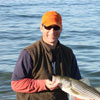How to Catch More Trout
By Tom Keer
Apr 06, 2016
There is a lot to learn about catching trout, much of which can be learned over time.
There is a lot to learn about catching trout, much of which can be learned over time. With the season upon us, here are four different approaches to put more fish in the net.
- Opportunistic feeding. Trout want to take in more calories than they expend. When the water temperatures are between 55 and 65 degrees a trout burns up one stomach-full of food per day (which means they must eat). When the water is warmer...or colder...they burn up that same stomach-full of food every four days (which means they don't need to eat). Take your water temp to know what to expect.
- Opportunistic feeding and Reading the Water. Unless there is a lot of food in fast current, trout will hang in the slower current and dart into the fast water to grab a passing meal. While waiting for your fly or lure they'll sit behind rocks (called pocket water), in pools (deep, slow-moving water), in runs (moderately deep water of average current speed), and behind deadfall. In ponds and lakes you'll find them around structure, at depth changes, and near inflows and outflows.
- Vary your approach. There are the imitation and attraction schools of thought. Imitations match the size, shape, and color of the insects or baitfish that the trout feed on. Attractor patterns match the size and shape of the food, but their colors are bright. Use them both until you figure out what the trout prefer.
- To stay or go. Sometimes it makes sense to work a feeding fish until you catch him. You'll need to change your approach, fly or lure, or rigging until you find the winning combination. Other times, though, it makes sense to keep moving until you find a fish that eats. There is a lot of satisfaction in working a fussy trout until he eats, but you might catch fewer (or smaller) fish for the day if you cover some ground.
To catch more trout you need to think like a trout, and once you do, you'll put many in the net. Make sure to review your state regulations before catch them!
Popular Posts









